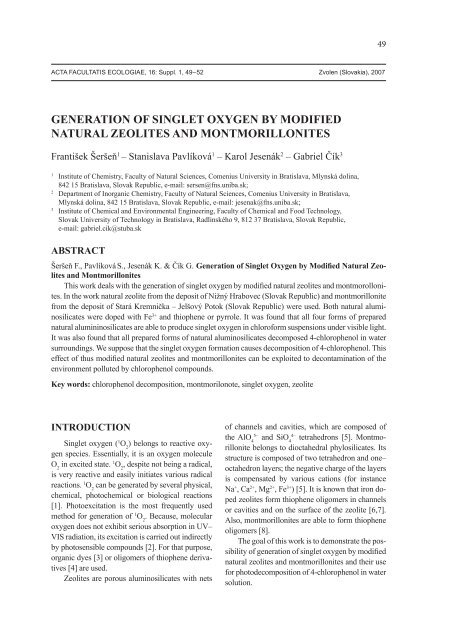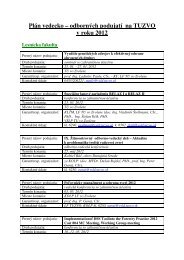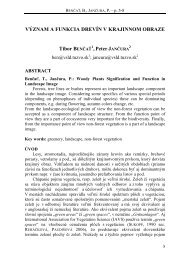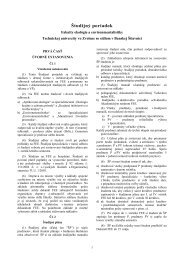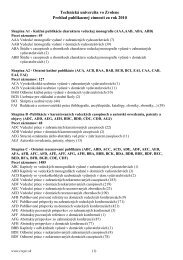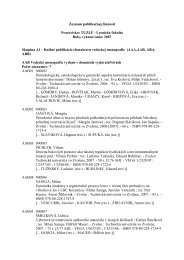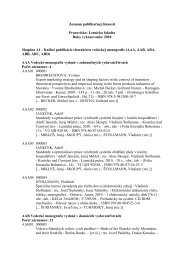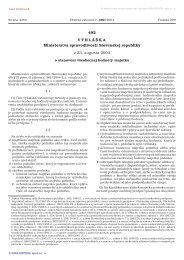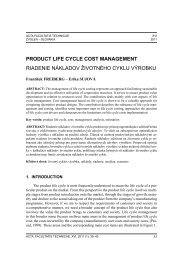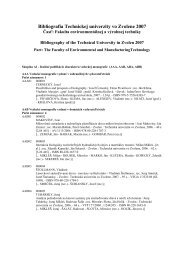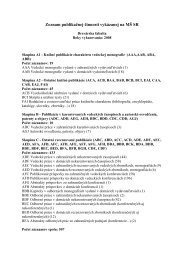49ACTA FACULTATIS ECOLOGIAE, 16: Suppl. 1, 49 – 52 Z<strong>vo</strong>len (Slovakia), 2007GENERATION OF SINGLET OXYGEN BY MODIFIEDNATURAL ZEOLITES AND MONTMORILLONITESFrantišek Šeršeň 1 – Stanislava Pavlíková 1 – Karol Jesenák 2 – Gabriel Čík 31Institute of Chemistry, Faculty of Natural Sciences, Comenius University in Bratislava, Mlynská dolina,842 15 Bratislava, Slovak Republic, e-mail: sersen@fns.uniba.sk;2Department of Inorganic Chemistry, Faculty of Natural Sciences, Comenius University in Bratislava,Mlynská dolina, 842 15 Bratislava, Slovak Republic, e-mail: jesenak@fns.uniba.sk;3Institute of Chemical and Environmental Engineering, Faculty of Chemical and Food Technology,Slovak University of Technology in Bratislava, Radlinského 9, 812 37 Bratislava, Slovak Republic,e-mail: gabriel.cik@stuba.skABSTRACTŠeršeň F., Pavlíková S., Jesenák K. & Čík G. Generation of Singlet Oxygen by Modified Natural Zeolitesand MontmorillonitesThis work deals with the generation of singlet oxygen by modified natural zeolites and montmorollonites.In the work natural zeolite from the deposit of Nižný Hrabovec (Slovak Republic) and montmorillonitefrom the deposit of Stará Kremnička – Jelšový Potok (Slovak Republic) were used. Both natural aluminosilicateswere doped with Fe 3+ and thiophene or pyrrole. It was found that all four forms of preparednatural alumininosilicates are able to produce singlet oxygen in chloroform suspensions under visible light.It was also found that all prepared forms of natural aluminosilicates decomposed 4-chlorophenol in watersurroundings. We suppose that the singlet oxygen formation causes decomposition of 4-chlorophenol. Thiseffect of thus modified natural zeolites and montmorillonites can be exploited to decontamination of theenvironment polluted by chlorophenol compounds.Key words: chlorophenol decomposition, montmorilonote, singlet oxygen, zeoliteINTRODUCTIONSinglet oxygen ( 1 O 2) belongs to reactive oxygenspecies. Essentially, it is an oxygen moleculeO 2in excited state. 1 O 2, despite not being a radical,is very reactive and easily initiates various radicalreactions. 1 O 2can be generated by several physical,chemical, photochemical or biological reactions[1]. Photoexcitation is the most frequently usedmethod for generation of 1 O 2. Because, molecularoxygen does not exhibit serious absorption in UV–VIS radiation, its excitation is carried out indirectlyby photosensible compounds [2]. For that purpose,organic dyes [3] or oligomers of thiophene derivatives[4] are used.Zeolites are porous aluminosilicates with netsof channels and cavities, which are composed ofthe AlO 45–and SiO 44–tetrahedrons [5]. Montmorillonitebelongs to dioctahedral phylosilicates. Itsstructure is composed of two tetrahedron and one–octahedron layers; the negative charge of the layersis compensated by various cations (for instanceNa + , Ca 2+ , Mg 2+ , Fe 3+ ) [5]. It is known that iron dopedzeolites form thiophene oligomers in channelsor cavities and on the surface of the zeolite [6,7].Also, montmorillonites are able to form thiopheneoligomers [8].The goal of this work is to demonstrate the possibilityof generation of singlet oxygen by modifiednatural zeolites and montmorillonites and their usefor photodecomposition of 4-chlorophenol in watersolution.
50MATERIAL AND METHODSChloroform (p.a.) was purchased from Centralchem(Slovak Republic). Pyrrole, thiophene and4-chlorophenol were purchased from Lachema(Czech Republic). Pyrrole and thiophene were freshlydistilled before experiments. 2,2,6,6-tetramethylpiperidine (TEMP) was purchased from Sigma-Aldrich(Germany).In this work was used <strong>vo</strong>lcanic tuff from thedeposit of Nižný Hrabovec (Slovak Republic) withmineral composition: 40–56 % clinoptilolite, 6.3–8.7 % feldspar, cristobalit 7.8–10.7 %, quartz 2.3–3.2, biotite 1 % and amorphous phase 22.5–40 %[9]. The zeolite was pulverized (grain ~1 mm) andthen by ion-exchange reaction doped with Fe 3+ bywater solution of FeCl 3(c = 0,2 mol dm –3 ). Thusdoped zeolite was dried and treated with pyrroleor thiophene. The guest molecules are bounded inthe cavity or on the surface of the zeolite during thistreating.Montmorillonite was isolated from 4 % watersuspension of bentonite from the deposit of StaráKremnička – Jelšový Potok (Slovak Republic).This bentonite contains calcium-magnesium montmorillonite.The chemical composition of this calciummontmorillonite is [Si 7,95Al 0,05] [Al 3,03Fe 0,22Mg 0,75]0 20(OH) 4(Ca 0,42Mg 0,04Na 0,01K 0,01) [10,11].Dopations by iron and then by thiophene or pyrrolewere carried out as in the case of the zeolite.The singlet oxygen was generated in suspension,which was composed of 2 ml of 10 –3 mol dm –3 chloroformsolution of TEMP and 20 mg of modified aluminosilicatesby the visible light (~ 100 W.m –2 ) froma 250 W halogen lamp passed through a 10 cm waterfilter. All suspensions were irradiated 15 min. at continualstirring by the magnetic stirrer.The experiment of 4-chlorophenol decompositionwas carried out in glass Erlenmeyer flaskswhich contained 10 ml water solution of 4-chlorophenol(10 –4 mol dm –3 ) and 100 mg modified aluminosilicatesby continual irradiation with visiblelight (12 W m –2 by 36 W TLD Philips neon tubes).The spectra of electron paramagnetic resonance(EPR) were registered by ERS 230 apparatus(ZWG Berlin, Germany), which operates in X-band(~ 9.3 GHz), with modulation amplitude 0.1 mTand microwave power 5 mW. The UV-VIS spectrawere recorded by the spectrophotometer Hewllet-Packard Diode Array 8254. All experiments werecarried out at the room temperature (25 °C).RESULTS AND DISCUSSIONThe incorporation of pyrrole and thiopheneinto modified zeolites and montmorillonite was accompaniedby change of the colour, initially orangealuminosilicates turned black. This black colouris caused by formation of oligomers of pyrrole orthiophene, respectively in the modified aluminosilicates[6–8]. The presence of oligomers in the Fe--zeolite with pyrrole and thiophene was documentedby registration of polarons in their EPR spectra(Fig. 1). These polarons have one unpaired electronand so exhibit the EPR signal in the free radicalregion. The spectroscopic constants for polaronswere g = 2.0012 and ∆B pp= 0.5–1.5 mT. Theindividually modified aluminosilicates contained2.3 10 16 –6.6 10 18 spin per gram (Fe-montmorillonitewith thiophene 2.3 10 16 and 6.6 10 18 with pyrrole,Fe-zeolite with thiophene 6.3 10 16 and 9.9 10 17 withpyrrole).The generation of 1 O 2was detected indirectlyvia its reaction with TEMP. It is known that the resultof the reaction of TEMP with 1 O 2is the 2,2,6,6--tetramethyl piperidine-N-oxide radical (TEMPO)[12]. In Fig. 2 is documented the formation ofTEMPO by visible light irradiation in chloroformsuspensions of our modified aluminosilicates. TheseEPR spectra consist of three lines of hyperfineinteraction of an unpaired electron with the nuclearspin of 14 N. The g factor of all central lines was2.0032 and the constants of hyperfine splittingwere 1.58 mT.In our previous work [7] it was demonstratedthat ZSM-5 zeolite doped with Fe and thiophenedecomposed 4-chlorophenol in water solution underthe visible light. Now we attempted to find outif prepared modified natural zeolites and montmorillonitesare able to decompose 4-chlorophenol.We found that natural zeolites and montmorillonitesdoped with Fe and pyrrole and thiophene areable to decompose 4-chlorophenol too. The decompositionof 4-chlorophenol by modified naturalaluminosilicates in the visible light was documentedspectrophotometrically (Fig. 3). The decreaseof absorption bands (226 and 280 nm) of 4-chlorophenolis evident after irradiation by visible lightof 4-chlorophenol water solution in the presenceof the modified zeolites and montmorillonites.The most effective in the decomposition of 4-chlorophenolwere Fe-zeolite doped with pyrrole andFe-montmorillonite doped with thiophene.
- Page 2 and 3: Acta FacultatisEcologiaeJournal of
- Page 4 and 5: OBSAH / CONTENTSISOL M., MICHALÍKO
- Page 6: 5ACTA FACULTATIS ECOLOGIAE, 16: Sup
- Page 12: 11ACTA FACULTATIS ECOLOGIAE, 16: Su
- Page 18 and 19: 17ACTA FACULTATIS ECOLOGIAE, 16: Su
- Page 20 and 21: 19are lower in ill patients compare
- Page 22: 21are considered as the most accura
- Page 25 and 26: 24- multimode cavities are usually
- Page 27 and 28: 26the load during its exposure to f
- Page 29 and 30: 28Tradescantia paludosa 02 test and
- Page 31 and 32: 30Tab. 5: Results of positive contr
- Page 34 and 35: 33ACTA FACULTATIS ECOLOGIAE, 16: Su
- Page 36 and 37: 35DISCUSSIONThe ionising radiation
- Page 38 and 39: 37ACTA FACULTATIS ECOLOGIAE, 16: Su
- Page 40 and 41: 39222Rn is produced by radioactive
- Page 42 and 43: 41180160140this reason we also pick
- Page 44: 435001450400350hKz0,8h [m]300250200
- Page 47 and 48: 46deposit is that stripped in off-l
- Page 49: 48TruenessTrueness was determined i
- Page 53 and 54: 52absorbance [a.u.]1,000,750,500,25
- Page 55 and 56: 54Tab. 1: Rrequirements determinati
- Page 57 and 58: 56Methods of VOC testing were set a
- Page 60 and 61: 59Tab. 6: ContinuedSamples withsurf
- Page 62 and 63: 61ACTA FACULTATIS ECOLOGIAE, 16: Su
- Page 64 and 65: 63One of the possible explanations
- Page 66 and 67: 65Ai - Ai-1 [Bq.m -3 ]86420-2-4-6-8
- Page 68 and 69: 67ACTA FACULTATIS ECOLOGIAE, 15: Su
- Page 70 and 71: 69BiodegradabilityThe great variety
- Page 72 and 73: 71degradation starts of late days,
- Page 74 and 75: 73Fig. 4 Treated (after 28 days of
- Page 76: 75parameters of the cutting process
- Page 80 and 81: 79Fraction: D (residual rest) prese
- Page 82: 81was not confirmed. Maximum of mer
- Page 85 and 86: 84Fig. 1 Schematic diagram of atomi
- Page 87 and 88: 86Alpha spectrometryAlpha spectrome
- Page 89 and 90: 8880007000y = 6622xR 2 = 0.939SIMS
- Page 92 and 93: 91ACTA FACULTATIS ECOLOGIAE, 16: Su
- Page 94 and 95: 93Gemer according to the German mod
- Page 96 and 97: 95Tab. 1 Results of the chemical an
- Page 98 and 99: 97Continuation of Tab. 2 Results of
- Page 100 and 101:
99Vlčia Dolina and from the reserv
- Page 102 and 103:
101ACTA FACULTATIS ECOLOGIAE, 16: S
- Page 104 and 105:
103mg.dm -3mg.dm -35,004,003,002,00
- Page 106 and 107:
105year and the average value repre
- Page 108 and 109:
107ACTA FACULTATIS ECOLOGIAE, 16: S
- Page 110 and 111:
109Sample site 1 Sample site 2 Samp
- Page 112 and 113:
111As for the sampling time (Fig. 5
- Page 114 and 115:
113ACTA FACULTATIS ECOLOGIAE, 16: S
- Page 116 and 117:
115Typha latifolia, Carex sp., Scir
- Page 118 and 119:
117conditions for decomposition of
- Page 120 and 121:
119ACTA FACULTATIS ECOLOGIAE, 16: S
- Page 122 and 123:
121from the background (derived fro
- Page 124 and 125:
12311. PETROVSKÝ, E., ELWOOD, B.:
- Page 126 and 127:
125ACTA FACULTATIS ECOLOGIAE, 16: S
- Page 128 and 129:
1272.52.0Correlation coefficient 0,
- Page 130 and 131:
129ACTA FACULTATIS ECOLOGIAE, 16: S
- Page 132 and 133:
131RESULTS AND DISCUSSIONTable 2 gi
- Page 134 and 135:
133ACTA FACULTATIS ECOLOGIAE, 16: S
- Page 136 and 137:
135V-1 BOREHOLEThe courses of 222 R
- Page 138 and 139:
137AV-2 (40m) 2006A ( 222 Rn) [kBq/
- Page 140 and 141:
139soaks into the soil, another par
- Page 142 and 143:
141ACTA FACULTATIS ECOLOGIAE, 16: S
- Page 144 and 145:
143Fig. 2 The continuous monitoring
- Page 146 and 147:
145Indoor radon activity concentrat
- Page 148 and 149:
147ACTA FACULTATIS ECOLOGIAE, 16: S
- Page 150 and 151:
149Fig. 1 Podlipa dump-fieldCanada)
- Page 152 and 153:
151concentrations of Fe. Cu. Cd. Ni
- Page 154 and 155:
153DUMP-FIELDREFERENCE SITEppm15001
- Page 156 and 157:
155Fig. 5 Compression of wood forma
- Page 158 and 159:
157decrease in the following order:
- Page 160 and 161:
159ACTA FACULTATIS ECOLOGIAE, 16: S
- Page 162 and 163:
161SPECIFIC EXAMPLES OFFACTORS THAT
- Page 164 and 165:
163ACTA FACULTATIS ECOLOGIAE, 16: S
- Page 166 and 167:
165The methods developed to incorpo
- Page 168 and 169:
167The effects of wind on ozone con
- Page 170 and 171:
169Fig. 6 Mean total and stomatal f
- Page 172 and 173:
171transport modelling in North Ame
- Page 175:
Acta Facultatis Ecologiae, Volume 1


